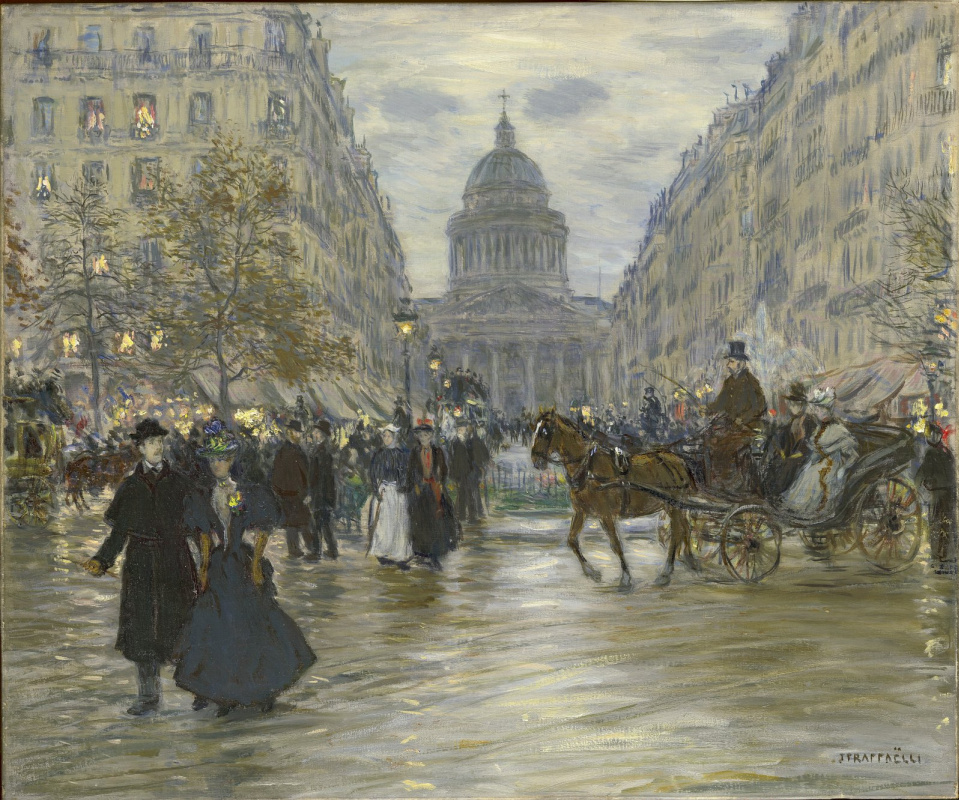log in
Enter site
Login to use Arthive functionality to the maximum
Boulevard Saint-Michel
Jean-François Raffaelli • Painting, Start XX centuries, 64×77 cm
Description of the artwork «Boulevard Saint-Michel»
The painting Boulevard Saint-Michel shimmers with all shades of grey and yellow – a flickering warm-pearly sky, an ochre-grey corridor of walls leading to the Pantheon’s mass, a grey, silvery, dirty citrine land. And on top of all, there is a scattering of radiant-yellow strokes: the dots of street lamps, squares of glowing windows, and long patches of light on the wet pavement.
A subject, a fresh colour, a light long stroke, a sketchy carelessness of painting - according to all these signs, this work should be considered impressionistic, but the classics of Impressionism didn't want to admit this. And Jean-François Raffaëlli himself, Italian by blood and Parisian by birth, was not desirable in their community. The significant participation of Raffaëlli in the fifth impressionist exhibition led to Claude Monet’s, one of the movement's founders’, leaving the group. He said that the organizers “opened the door for the self-taught painters”. Together with him, such “monsters” of Impressionism like Renoir, Sisley and Cézanne also refused to participate in the exhibition.
Basically, it wasn’t the fault of Raffaëlli or Gauguin, whose paintings were not really appreciated by Monet, but it was Degas to blame. He did not just invite both of them to the exhibition but also selected 37 works by Raffaëlli for the display.
Monet’s and other “founding fathers’” dislike for Raffaëlli’s paintings can be understood: with all his passion for Impressionism, the artist painted not just “the first impression” of the evening, autumn or boulevard, but rather a well thought out and considered imitation of “the first impression”. It is easy to feel how he studied the artistic devices of his forerunners and colleagues, choosing whose coloration, composition or the manner of drawing a crowd to borrow, in order to make his individual, but still extremely eclectic in details, product. However, there’s no denying that despite all the replication and compilation, this painting is still very charming. Perhaps, it’s more about that genuine pleasure received from his own art, which the artist conveys to the viewer even now.
Author: Oksana Sanzharova
A subject, a fresh colour, a light long stroke, a sketchy carelessness of painting - according to all these signs, this work should be considered impressionistic, but the classics of Impressionism didn't want to admit this. And Jean-François Raffaëlli himself, Italian by blood and Parisian by birth, was not desirable in their community. The significant participation of Raffaëlli in the fifth impressionist exhibition led to Claude Monet’s, one of the movement's founders’, leaving the group. He said that the organizers “opened the door for the self-taught painters”. Together with him, such “monsters” of Impressionism like Renoir, Sisley and Cézanne also refused to participate in the exhibition.
Basically, it wasn’t the fault of Raffaëlli or Gauguin, whose paintings were not really appreciated by Monet, but it was Degas to blame. He did not just invite both of them to the exhibition but also selected 37 works by Raffaëlli for the display.
Monet’s and other “founding fathers’” dislike for Raffaëlli’s paintings can be understood: with all his passion for Impressionism, the artist painted not just “the first impression” of the evening, autumn or boulevard, but rather a well thought out and considered imitation of “the first impression”. It is easy to feel how he studied the artistic devices of his forerunners and colleagues, choosing whose coloration, composition or the manner of drawing a crowd to borrow, in order to make his individual, but still extremely eclectic in details, product. However, there’s no denying that despite all the replication and compilation, this painting is still very charming. Perhaps, it’s more about that genuine pleasure received from his own art, which the artist conveys to the viewer even now.
Author: Oksana Sanzharova


